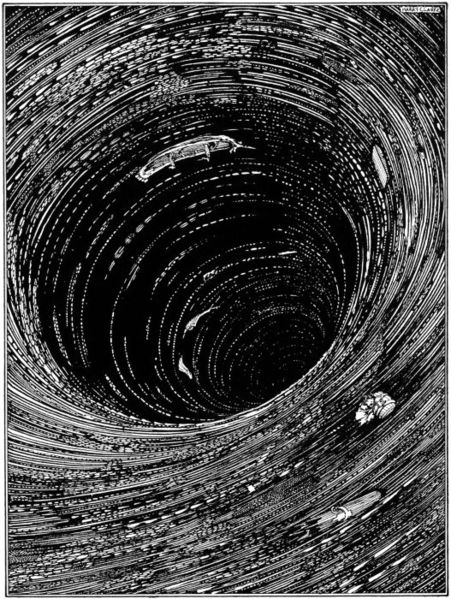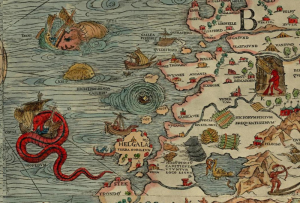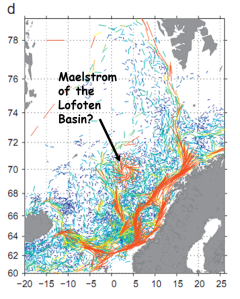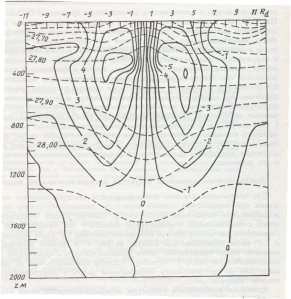
Fig. 1. Artist Harry Clarke’s 1919 illustration for “A Descent into the Maelström” (source: Wikipedia)
In 1841 the American poet and writer Edgar Allan Poe published a story entitled ‘A descent into the Maelstrom’ (Poe, 1841). This early form of science fiction contains a breathtaking episode of a ship immersing into a giant whirlpool close to the Norwegian coast (fig. 1). In the book, two observers watch from the top of a mountain as the Maelstrom forms out at sea:
“In a few minutes more, there came over the scene another radical alteration. The general surface grew somewhat more smooth, and the whirlpools, one by one, disappeared, while prodigious streaks of foam became apparent where none had been seen before. These streaks, at length, spreading out to a great distance, and entering into combination, took unto themselves the gyratory motion of the subsided vortices, and seemed to form the germ of another more vast. Suddenly –very suddenly– this assumed a distinct and definite existence, in a circle of more than half a mile in diameter. The edge of the whirl was represented by a broad belt of gleaming spray; but no particle of this slipped into the mouth of the terrific funnel, whose interior, as far as the eye could fathom it, was a smooth, shining, and jet-black wall of water, inclined to the horizon at an angle of some forty-five degrees, speeding dizzily round and round with a swaying and sweltering motion, and sending forth to the winds an appalling voice, half shriek, half roar, such as not even the mighty cataract of Niagara ever lifts up in its agony to Heaven.“

Figure 2. The Maelstrom off Norway, as illustrated by Olaus Magnus on the Carta Marina, 1539 (source: Wikipedia)
Of course, the description is fictional and exaggerated but the phenomenon is real! The origin of the whirlpool is quite obvious and is generated by a combination of complex topography and strong tidal currents between islands in Lofoten archipelago. The whirlpool that aroused Poe’s imagination was already plotted on the map in 1539 (fig. 2). Take a look at the fig. 3 which shows mean velocities on the surface (description follows) in the Nordic Seas. At the point around 70oN and 3oE, which also happens to be the center of 3700 m deep Lofoten Basin, there is a closed circulation that has velocities as strong as the main current jets of the Norwegian Atlantic current. Does this mean that there is yet another ’Maelstrom’ in the Lofoten Basin? Does it pose any danger for ships? Let’s have a closer look at the phenomenon!

Figure 3. The surface drifters mean velocities estimated by means of “clustering” algorithm (including the topography in the clustering, only significant estimates are plotted). Arrow in the upper left corner marks a speed of 30 cm/s (source: Fig. 8d from Koszalska et al., 2011).
The 1995 findings
In 1995 we published two articles (Ivanov & Korablev 1995a, Ivanov & Korablev 1995b) about a vortex in the Lofoten Basin. We inferred conclusions were from a sequence of oceanographic surveys and simple analytical and balance models. Using the sparsely located observations we described the phenomenon as a ~30 km diameter anticyclonic (clockwise) vortex rotated counterclockwise in the center of the basin restricted by the 3200 m isobath. Density distribution on a section across the vortex has a specific form of a convex lens. The vortex formation and stability was explained by winter convection which regenerates the density anomaly and thus reinforces the accompanied circulation (fig. 4). We have also suggested a seasonal cycle in the vortex size and intensity, as well estimated that the vortex can survive up to 1.5 years without external energy supply.

Figure 4. Mean density (dashed lines) and speed of geostrophic current (solid lines) along the section through the center of anticyclonic intrapycnocline lens in the Lofoten Basin. The horizontal axis show the size of the vortex in Rossby’s radii with one Rossby radius about 10 km for the vortex’s latitude (source: Fig.1 from Ivanov & Korablev, 1995a)
A resurgence of interest
Years passed, new instruments, satellite observations, and model simulations came online, providing new and more complete information about processes in the Lofoten Basin.
In 2007, A. Köhl (2007) from Hamburg University proposed a new paradigm of the vortex formation from analysis of the high-resolution ocean model output and altimetry data: ‘the vortex results primarily from anti-cyclonic eddies shed from the eastern branch of the Norwegian Atlantic Current’; “the Lofoten Basin plays a crucial role for attracting anti-cyclones into the trough and for enabling the dynamical stability of the vortex”. Although Köhl confirmed that convection and topographic control contribute to the regeneration of the anticyclone, he also proposed another mechanism: merging of anti-cyclonic eddies. The model reproduced merging events and sometimes the eddy merged with the central anticyclone to create stronger vortex resembling Edgar Poe’s story: ‘to form the germ of another more vast [vortex]’.
The idea that the Lofoten Basin is a ‘catching area for anti-cyclonic eddies’ got confirmation from several sources.
Since the early 1990s free drifters (free-floating buoys with instruments attached) became widely used for the investigation of ocean circulation. Koszalka et al. (2011) retrieved mean current-velocities and eddy kinetic energy (energy associated with eddies) from the trajectories of the surface drifters, which were deployed in the Nordic Seas for 20 years. The large, 150 km in diameter, eddy in the center of the Lofoten Basin is undoubtedly the most extraordinary anomaly in the surface velocities (fig. 3). The size of the eddy is much larger in comparison with the 1995-estimates; most likely due to the underestimation of the eddy’s movements. The distribution of the eddy kinetic energy has confirmed a connection between eddies shed from the Norwegian Atlantic Current and the central Lofoten vortex.
In 2013, Volkov et al. called the central part of Lofoten Basin a “hot spot of intense synoptic-scale variability of the Norwegian Sea” because the sea surface height variability shows an absolute maximum here. They also found that eddy propagation is strongly controlled by topography and that eddies spiral cyclonically towards the center of the basin with rotation ideally resembling the mid-depth circulation. They suggested that the rotation has a wavelike nature originating from topographic Rossby waves (freely propagating modes of large-scale variability controlled by variations in planetary vorticity and depth). Satellite altimetry supports the theory observing wave propagation without the corresponding transport of mass. The latter fact explains why the surface drifters do not follow cyclonic rotation in the Lofoten Basin.
Raj et al. (2013) stressed uniqueness of the “Lofoten Vortex” for the whole Nordic Seas region highlighting extremes in several vortex-related parameters. They estimated the vortex mean radius (~46 km), interior speed (~30 cm/s), and mean drift speed of the cyclonically rotating center (~ 4 cm /s). Distinct seasonality was found in the vortex radius with winter contraction and summer expansion. Analysis of altimetry data gave astonishing coincidence with Köhl (2007) model simulations providing observational evidence of the “Lofoten Vortex” and its reinforcement by merging with anticyclonic eddies.
To sum up, the existence of the quasi-permanent vortex in the Lofoten Basin, first described in 1995, has been repeatedly confirmed by modern instruments and analysis methods including satellite altimetry, drifters and model simulations. The “Maelstrom of the Lofoten Basin” does exist although it is not capable of swallowing ships as in Edgar Poe’s story from 1841. Maximum standard deviation of the sea surface height in the Lofoten Basin is only 12 cm (see fig. 1a in Volkov et al., 2013), but is still the highest for all offshore areas in the Nordic Seas. It is splendid that understanding of the oceanographic processes in this area has recently reached a new level, thereby lifting the curtain of secrecy from one more oceanic mystery.
One can question the climatic importance of this vortex living in the comparatively small area over the Lofoten Basin. Indeed, the size is much smaller than the dimension of the basin sheltering the vortex. However, its large vertical extent and permanent movement help to maintain the enormous deep reservoir of heat ready to expose to the atmosphere. Moreover, favorable stratification in the Lofoten Basin creates conditions for highest rates of dense water production in the Nordic Seas (Isachsen et al., 2007) feeding the global thermohaline circulation.
References
Isachsen, P. E., C. Mauritzen, and H. Svendsen (2007), Dense water formation in the Nordic Seas diagnosed from sea surface buoyancy fluxes, Deep Sea Res., Part 1, 54, 22-41, doi:10.1016/j.dsr.2006.09.008.
Ivanov, V. V., and A. A. Korablev (1995a), Formation and regeneration of the pycnocline lens in the Norwegian Sea, Russ. Meteor. Hydrol., 9,62–69.
Ivanov, V. V., and A. A. Korablev (1995b), Dynamics of an intrapycnocline lens in the Norwegian Sea. Russ. Meteor. Hydrol., 10,32–37.
Koszalka, I., LaCasce, J.H., LaCasce, J.H., Andersson, M., Orvik, K.A., Mauritzen, C., (2011), Surface circulation in the Nordic Seas from clustered drifters. Deep-Sea Res. I 58 (4), 468–485.
Köhl, A. (2007), Generation and stability of a quasi-permanent vortex in the Lofoten basin, J. Phys. Oceanog,. 37, 2637-2651.
Poe, Edgar Allan (1841), A descent into the Maelstrom (http://classiclit.about.com/library/bl-etexts/eapoe/bl-eapoe-descent.htm)
Raj, R.P., L. Chafik, J.E.Ø. Nilsen, and T. Eldevik, (2013), The Lofoten Vortex of the Nordic Seas. In review Deep Sea Res.
Volkov,D.L.,T. V. Belonenko, and V. R. Foux (2013), Puzzling over the dynamics of the Lofoten Basin – a sub-Arctic hot spot of ocean variability, Geophys. Res. Lett., 40,738–743, doi:10.1002/grl.50126







